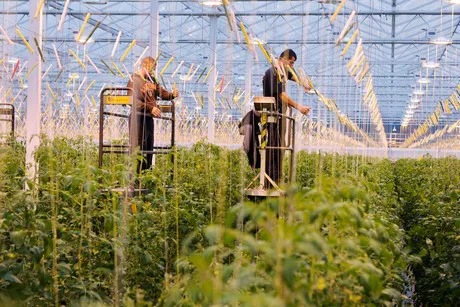
Lighting is crucial
"Lighting is a crucial part of our company," said van Straalen. "We want to deliver premium tomatoes year round and I would dare to say that in winter it is physically impossible to deliver top quality tomatoes without using supplemental lighting. Even in the Mediterranean the climate is not suitable for this. Year after year more retailers and consumers, both in the Netherlands and in the United Kingdom want to have premium tomatoes, which are know for their that taste. We can deliver those premium tomatoes, but we need lighting to grow them."
"In addition to the benefits of being able to supply quality, keeping your customers in winter and making better use of your facilities like greenhouse and electricity, it also changes the way you manage your greenhouse," says Gert. "Normally the greenhouse feels depressing in winter, it's cold and wet, your sales have stopped and you are cleaning up. When you have your lights on in the dark winter you go from your warm home to the warm lit greenhouse, where life is and where things are growing. That remains unreal."

Simpler and more challenging
In addition, van Straalen explained that cultivation in winter is on one hand also simpler and at the same time more challenging. "You have complete control over the climate because it is cold outside. In summer you depend on the influence of the weather, in winter you are the boss. You have less conditions to take into account and therefore also no excuses. If you ruin things in winter, you just did not do your job properly."
HPS or LED?
But what kind of lighting is it all about? Van Straalen compared HPS, a hybrid system and a LED system and explained his personal preferences. "Which system is best for a grower is largely dependent on cost of electricity. The cost of investment in LED is higher, but your energy consumption is much lower. At an electricity price below 80 euro per megawatt, HPS is often more interesting. At the end of the day it’s about your ROI."
Also the greenhouse height (5 meters is a minimum height for HPS) and lamp durability (Current LED output drops at 30,000 hours lighting by 10%) and controllability of LED lighting (various spectra) plays a role.

Another important point for van Straalen is radiant heat emitted by HPS lamps. "Most LED lamps hardly produce any heat, while HPS lighting produces radiation heat which triggers the plant to evaporate. It allos you to creae a generative plant and a vital climate. This starts the juice transport within the plant and the calcium reaches the fruits. Which brings the taste in your tomatoes. And that’s what it’s all about for us: taste, taste and taste."
For Thaneth Earth, the lit cultivation is an Unique Selling Point in the UK. "We are the only one in the UK who are able to deliver quality tomatoes on this scale in winter."
Future LED
Does the preference of van Straalen stay with HPS? The future is still LED, isn’t it? He sees that too. "LEDs will continue to improve, and eventually it will be preferred by growers and by us as well, but the question remains when. At this time it is still far too expensive, while it's expected that the cost of electricity will drop. That also changes the cost of lighting and the choice of lamps."
Nonetheless, the grower keeps an eye on new possibilities. "Plasma lamps are currently being developed. While these lamps almost do not emit any heat, their wavelength is almost the same as that of the sun. It does not get more natural than that…. But let’s see what the future brings."
"With lamps we make taste," Van Straalen concluded. "And with taste we generate demand from customers. For us, lighting has become an essential part of the company. Without lighting, our company would not be the same."






